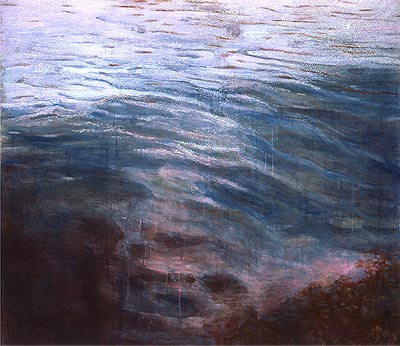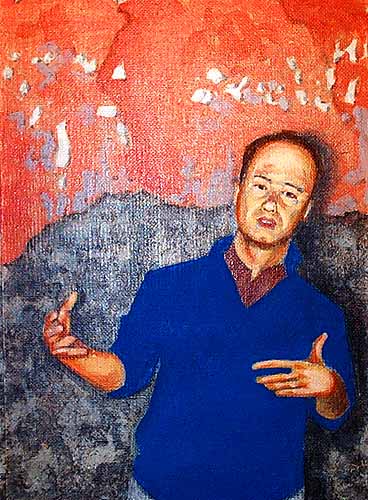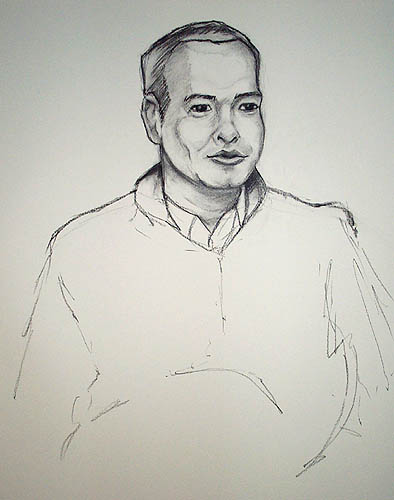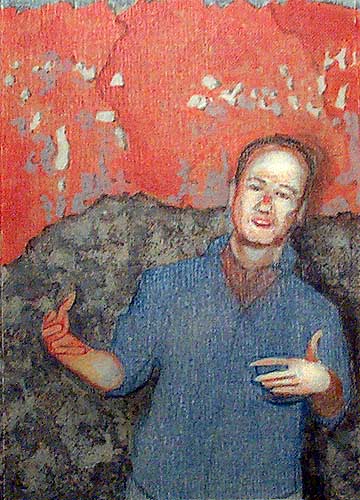The purpose of this blog is to share a journey towards creativity/creation. It is a place to give voice to my thoughts on art and studio practice and to record the process I am using to find my message as an artist.
Wednesday, June 22, 2005
Less toxic and environmentally-friendly art supplies
Without sounding too much like an infomercial I want to share a great resource with you, Eco-House. Eco-House makes a solvent system that works with the painting supplies I already use. I don't have to change my materials just the solvent. Eco-House offers their solvent in a variety of strengths. I use the strong solvent to disolve varnish crystals and wax and the extra mild to thin paints and clean brushes. I have used the products for these 6 years without a problem either with my health or with the paint surfaces.
For more information visit Eco-House at:
http://www.eco-house.com/art_supplies.html
Artist Material of the Week: Cobalt Drier
Cobalt Drier is used with oil paints to reduce the time it takes for the surface of the paint film to dry.
Driers are best used with techniques that call for thin applications of paint, as in glazes. If your technique includes a thick impasto then cobalt driers are not for you. There are other driers that will work with thick bodied paint surfaces.
Pros:
- Reduce the handling time.
- Ease of use.
Cons:
- Not to be used in water based paints or varnishes.
- Can cause wrinkling and cracking when used in excess.
How does it work?
Using a paint drier with a drying oil, such as linseed, accelerates the absorption of oxygen. Drying oils dry through a process called oxidation. The oil molecule has one or two sites on it that bond with oxygen forming a new molecule. As this process occurs, these new molecules bond together in a process called polymerization. A solid film is left when the process is complete. This process will take place without the addition of a drier but will take significantly more time.
How much should you use?
The amount depends on the percentage of active ingredient in the Cobalt Drier solution you purchase. You will need to experiement with the painting medium and oils that you use. Begin by adding just a few drops to the oil and medium as you mix your paints on the pallette.
Warning:
Cobalt is a very toxix substance. In large concentrations it has been shown to be very harmful to one's health. Keep this and all painting materials out of reach of children and use sparingly and with caution. For more information on art materials and safe studio practices watch this site or visit:
Monday, June 20, 2005
The Informed Creator
"An artist at work upon a painting must be two people, not one. He must function and act as two people all the time and in several ways. On the one hand, the artist is the imaginer and the producer. But he is also the critic, and here is a critic of such inexorable standards as to have made McBride [a conservative anti-communist art critic] seem liberal even in his most illiberal moment."
Shahn continues, describing the role of the inner critic as one of the obstruction to the creative progress but also as a governor of content:
"So the inner critic has stopped the painting before it has even begun. Then, when the artist strips his idea down to emotional images alone and begins, slowly, falteringly, moving toward some realization, that critic is constantly objecting, constantly chiding, holding the hand back to the image alone, so that the painting remains only that, so that it does not split into two things, one the image, and another, the meaning."
What I have taken from this is that it is not enough that an artist have skill with material and technique. It is necessary that the artist be able to develop the image and its meaning simultaneously. The meaning of the painting must be an expression of self or deeply connected to the artist's way of thinking. The image is a physical manifestation of the thought process from idea to the object or work of art.
Shahn continues to describe the connection between personal thoughts and beliefs and the work:
"It became uncomfortably apparent to me that whatever one thinks as well as whatever one paints must be constantly reexamined, torn apart, if that seems to be indicated, and reassembled in the light of new attitudes or new discovery. If one has set for himself the position that his painting shall not misconstru his personal mode of thinking, then he must be rather unusually alert to just what he does think."
In the ideas that I am turning into images I wonder what of them is a reflection of my beliefs? My images need to contain more of my self. To date my images have been mine because I made them. Often they reflect only my skill with tools and materials. I have been content with that but now I want more.
Tuesday, June 14, 2005
May Stevens

May Stevens paints on canvas and paper with acrylic. The color depth is amazing. I hadn't thought acrylics were capable of this. If you are in Minneapolis you should see this show.
In many of her pieces the highlights are words she has written with jel pen. The words are her own or are quotes that compliment the piece.
The Minneapolis Institute of Arts, US Bank Galleries, June 11, 2005 through July 31, 2005
The work continues
I have started to reread Ben Shahn's the Shape of Content. A humanities professor of mine, Stewart Lawler, gave my copy to me when I was a sophomore in art school. I found it useful then and am looking back to see what I can relearn from it now. I have gained so much since 1989. I am I will interpret these writings differently now.
I will share and comment on what I am reading here as I find useful passages.
Sunday, June 12, 2005
Update on study for Up Against the Wall No. 2

I have been working on using color to build form in the face and hands. I will post a better image soon.
Friday, June 10, 2005
New Drawing

Wednesday, June 08, 2005
Study: Up Against the Wall No. 2
I will post a painting, drawing, or images of the works in progress each day.

This is the second piece in a series of works. Each of these represents a portrait of a friend. Each will be shown in a shallow space against a wall. The wall might be decorated with a pattern as in the first piece or with the texture of a distinct architectural wall, as in this example.
Tuesday, June 07, 2005
Intelligent people make indifferent painters?
"I've grown to believe that a really intelligent man makes an indifferent painter. For painting requires a kind of blindness- a partial refusal to be aware of all the options. An intelligent man will know more about what he is drawing than he will see and in the space in between knowing and seeing he will become constrained; unable to pursue an idea strongly; fearing that the discerning, those he is trying to please, will find him wanting if he does not only put in what he knows but also what they know."
While watching this film and hearing this quote it made me think about the reasons behind my hesitation to work. I am still thinking about who I am trying to please. I am certain that I fear failure. I have resolved to change my behavior and work regardless of outcome. If I wait to work only when I am sure that the results will be satisfactory then nothing gets done.
Do I think to much about what it is that I am drawing and painting? Is that a bad thing? Is my lack of productivity/motivation a result of overthinking?
This web log will keep me honest. In order to record my progress I need to post new work daily. I am sure that some of what I create will be good, some bad, and some indifferent.
First Post
I have created this site as a daily journal of my search for creativity and productivity. I am an artist. I make pictures. I have been out of art school for many years. I have spent quite a bit of my energy on a career and livlihood. Much of which did not include artmaking. I need to make artmaking a larger part of my life and career. This is the journey I am on.
Along the way I hope to raise issues related to making art and studio practice. I also want to share some ideas I have formed about the meaning of art and its place in our culture.
Thanks for visiting. Please comment on what you read and see here. Come back often.
Treden